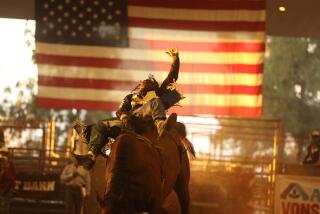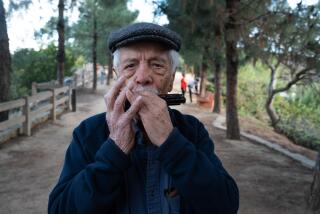The Cowboy in This 92-Year-Old Just Won’t Die
DENVER — When Alonzo Pettie started performing in rodeos, Denver was a small cow town with dirt roads. By the time he stopped riding horses, the city had become a booming metropolis and a haven for high-tech firms.
“I’ve seen it all, from cowboys and horses to cars and folk in suits,” said Pettie, 92, who walks with a cane these days, but still lives in his small home.
The dark wood paneling in the living room is wallpapered with his history: weathered black-and-white snapshots of horses, bulls and smiling cowboys in polished boots and hats. Ribbons, trophies, autographs and certificates from his rodeo days clutter tables and dressers.
“There ain’t nothing like a good, solid ride. I don’t care where you are or who you are. It’s just like music, smooth and perfect if you do it right,” he said.
Pettie is a living memory of the West. He has spent much of his life breaking horses and working as a ranch hand. In his nearly 25 years on the rodeo circuit, he rode bucking broncos and bulls, although segregation and racism kept him out of major competitions.
He later toured the country speaking about his experiences and was featured in a Levi Strauss jeans ad.
Standing this day on the porch of his apartment, smack-dab in the middle of Denver, Pettie looks out of place with his green boots, gray slacks, plaid Western shirt and cowboy hat. His face is remarkably free of wrinkles, and he wears five gold rings, one with diamonds in the shape of a horseshoe, mementos of his riding days.
Pettie, named for a grandfather born in slavery, was born in 1910 on a Texas farm. His father died when Pettie was a teenager, and he started supporting himself by breaking horses. A rancher taught him to ride, and took him to rodeos in Texas and Oklahoma.
Black men weren’t allowed to ride in the main rodeos then, so Pettie made his money by riding as pre-show entertainment.
“You just did your best, rode for yourself and the people watching, and hopefully you took home some money too,” he said. “But it sure could be dangerous sometimes if you get an angry bull.”
At a 1929 rodeo in Odessa, Texas, Pettie was bucked from a bronco and dislocated his shoulder, but he went on to win the bull-riding contest that same day with his arm in a sling. He suffered many other injuries.
“You just get back in there, get moving and get on that bull,” he said.
One of the most famous black cowboys was Bill Pickett, who invented bulldogging, a rodeo sport where a man wrestles a steer to the ground. Others, like Pettie, went mostly unnoticed because they were shut out of the white-only rodeos.
Pettie and a friend put together Colorado’s first all-black rodeo in the late 1940s. While competing, Pettie broke his pelvic bone for a second time and spent three months in a body cast.
After that, he stopped riding bulls but kept riding tamer horses. He was named best-dressed cowboy in a competition while he worked at Sears & Roebuck. His days as a rodeo champion faded away, but he continued to participate and rode in the Bill Pickett Invitational Rodeo until age 77.
Pettie and other black cowboys are featured in the Black American West Museum in Denver, founded by Paul Stewart.
“His stories were just amazing,” Stewart said. “When I met him, I knew that he would be one of the men I’d include in the exhibits about cowboys. He was kind of the granddaddy of them.”
Stewart travels around the country lecturing about blacks in the West. Pettie sometimes travels with him and speaks about his experiences.
“I’m a farm boy from Iowa and when I was young, I didn’t know people like Alonzo existed,” Stewart said. “I never saw any black cowboys, but they were out there, the Bill Picketts and the Alonzos, paving the way.”
Charles Sampson, who in 1982 was the first black man to win the Professional Rodeo Cowboy Assn.’s bull-riding championship, says Pettie was a pioneer.
“Black people are a part of the West’s history and heritage, and people like him made it easier for others to see it, even though they had it rough all the way around,” Sampson said. “I’m just a product of him. He planted the seed, and I’m just one of the apples that fell from the tree.”
Pettie’s only daughter, Ernestine Himes, and her family live in Donaldsonville, La.; they visit Pettie as often as they can. Himes says her father’s other companion is his horse, Blue.
“I’m too old now to go out there and see him like I used to,” Pettie said. “But if I had my legs again, I’d be out there, riding in the rodeos all over again. You know, the cowboy in me just ain’t gonna die.”
More to Read
Go beyond the scoreboard
Get the latest on L.A.'s teams in the daily Sports Report newsletter.
You may occasionally receive promotional content from the Los Angeles Times.










